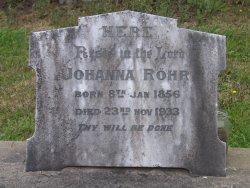![]()
and the Herrnhut Commune, Victoria
1) Krummnow in South Australia
2) In Victoria - founding of Herrnhut commune
3) Hill Plain commune moves to Herrnhut
4) Krummnow's death
 The
Herrnhut commune declined rapidly after Krummnow's death on 3rd October 1880
(noone knew how old he was). Only eight people still lived in the commune when
he died. The commune was in debt, but the remaining members continued working
the property as best they could, whilst embarking on complicated and extended
legal proceedings. Ownership of the commune land was granted to the remaining
communards on December 20, 1886. Unfortunately, there was an accumulated debt
of almost 5000 pounds and in 1889 the property was transferred to Alfred Hodgson,
a Melbourne lawyer, to settle the debt. Negotiations with the purchaser resulted
in the remaining Herrnhut communards being allowed to occupy the stone buildings
for as long as they needed to. Today most buildings have been taken apart and
the material used for building elsewhere.
The
Herrnhut commune declined rapidly after Krummnow's death on 3rd October 1880
(noone knew how old he was). Only eight people still lived in the commune when
he died. The commune was in debt, but the remaining members continued working
the property as best they could, whilst embarking on complicated and extended
legal proceedings. Ownership of the commune land was granted to the remaining
communards on December 20, 1886. Unfortunately, there was an accumulated debt
of almost 5000 pounds and in 1889 the property was transferred to Alfred Hodgson,
a Melbourne lawyer, to settle the debt. Negotiations with the purchaser resulted
in the remaining Herrnhut communards being allowed to occupy the stone buildings
for as long as they needed to. Today most buildings have been taken apart and
the material used for building elsewhere.

Grave of Johanna Röhr, Tabor cemetery
Johanna was one of the children that were born in the commune.
There are some stories about Krummnow's burial which are part of the oral folklore of the area. They are not believed to be true. E.g.:
1) It is said that he was buried face-downwards. Krummnow used to boast that when his time came he would rise up to heaven and be taken into the clouds as Christ was. The Lutheran neighbours regarded this as blasphemous, so they spread the story that Krummnow was buried face-downwards, so that if his prediction of raising himself came true, he would not go in the direction of heaven, but rather, go the opposite way to hell, where many felt that he belonged. An embellishment to this story is that a very large rock was placed over his body, so that if Krummnow was smart enough to work out that he was going the wrong way, the rock would ensure that he stayed where he was meant to be.
August Hildebrandt, Herrnhut's baker and long-term member of the commune, delivered the eulogy at the funeral, and he respected Krummnow greatly and would have buried him in an appropriate way.2) It is also said that at the burial a grieving swagman, who had often worked for the commune and liked Krummnow, tried to jump into the grave. There is no proof of this.
Summarised from:
Huf, Betty. 2001. Personal communication.
Lodewyckx, Prof. Dr A. 1932. Die Deutschen in
Australien. Ausland und Heimat Verlagsaktiengesellschaft, Stuttgart.
See also:
Meyer, C. 1978. "Two Communes in 19th Century
Victoria". In: Victorian Historical Journal, Vol. 49, No.4.
| Top | Back
| Chronology | Issues
| Students | Site Map |
auf Deutsch |
| Primary Sources (in German) | Bibliography
| Search |
German Australia © D. Nutting 2001